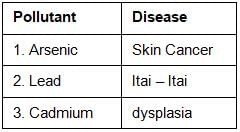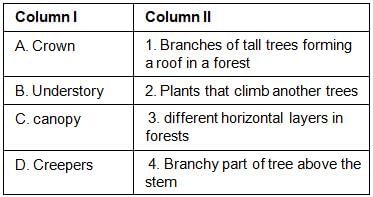Test: Class 7 General Science NCERT Based - 4 - UPSC MCQ
30 Questions MCQ Test Science & Technology for UPSC CSE - Test: Class 7 General Science NCERT Based - 4
The United Nations celebrate world water day?
Consider the following —
1. Evaporation
2. Transpiration
3. Condensation
Which of the above is/are responsible for the transformation of water droplets forming on the surface of a glass full of ice?
| 1 Crore+ students have signed up on EduRev. Have you? Download the App |
Consider the following statements regarding water cycle:
1. Water enters the air through evaporation and condensation.
2. Transpiration plays an important role in bringing the water back to the earth’s surface.
3. Water present in the air forms clouds and reaches the surface of the earth in the form of rain, snow and hail.
Which of the statements given above is/are correct?
Which of the following are not the liquid forms of water?
A. Snow
B. Lake water
C. River water
D. Water vapour
E. Ice
Choose the correct options :
Seas and oceans are full of water on earth. However, a very small percentage of water present on earth is available for us. This percentage is roughly:
“Every Drop Counts” is a slogan related to
Which of the following things should be present in drinking water?
Which of the following is a traditional method of collecting water?
The process of recharging ground water using rain water is called
Which of the following is the correct sequence of food chains?
In the context of decomposition, which of the following assertions is/are correct?
1. Decomposers feed upon the dead plant and animal tissues and convert them into a dark coloured substance called humus.
2. These are helpful in maintaining the supply of nutrients for plants and animals.
Use the code given below to choose the correct answer.
Select the chain that contains primary consumers:
The correct arrangement in the order from upper layers to lower layer in forests is:
Self explanatory.
Consider the following statements regarding adaptation in plants and animals.
1. The presence of specific features or certain habits, which enable a plant or an animal to live in its surroundings, is called adaptation.
2. A person who lives in the plains, breathes rapidly in a hilly region, but becomes normal after a few days. This is an example of adaptation.
Which of the statements given above is/are correct?
Through which of the following parts does cactus photosynthesise?
In India the area under forest cover is about the total area?
Consider the following:
1. Growth
2. Response to stimuli
3. Reproduction
Which of the above is/are symptoms of living things (plants and animals)?
Plants take in air during respiration. What do the plants do in the next step?
The term Municipal Solid Waste (MSW) is generally used to describe:
What is true about Aerobic bacteria?
Which of the following can be found as pollutants in the drinking water in some parts of India?
1. Arsenic
2. Sorbitol
3. Fluoride
4. Formaldehyde
5. Uranium
Select the correct answer using the codes given below.
With reference to sources of water pollution, which of the following is/are true?
1. Natural sources
2. Domestic sources
3. Agricultural sources
4. Industrial sources
Select the correct answer from the following codes
Which of the following pairs are correctly matched?

Select the correct answer from the following codes
With reference to Eutrophication, Which of the following is/are true?
1. It is phenomenon of nutrient enrichment of a water body
2. It depletes the water of dissolved oxygen (DO).
3. Human activities are mainly responsible for the eutrophication
Select the correct answer from the following codes
What minerals are found in the run-off from agricultural land and treated and untreated sewage effluents, which are highly responsible for eutrophication of water bodies?
The GAP (Ganga Action Plan) – a project to clean up the polluted waters of the Ganga - plans to intercept and divert municipal sewage falling into the river from 25 large urban conglomerates in three states.
Wetlands are very rich and diverse ecosystems. Of the wetlands of international importance in the world, a large number are subject to moderate or high threat. Which convention signed in Iran protects this specific ecosystem (wetlands) on a global basis?
In a survey recently conducted by the CGWA (Central Ground Water Authority) and CPCB (Central Pollution Control Board), the groundwater samples in one-fourth of the neighborhood tested in New Delhi were unfit for drinking. They contained high levels of two minerals that are not eliminated by ordinary water filters and are extremely harmful at high concentrations.
Which sector is the single-largest consumer of fresh water in India?
|
146 videos|358 docs|249 tests
|
|
146 videos|358 docs|249 tests
|


















